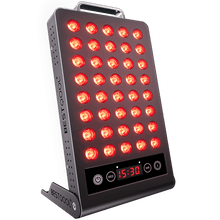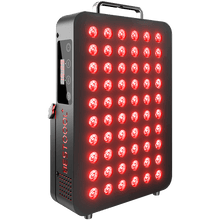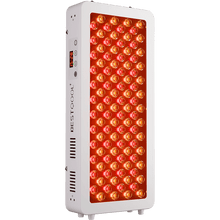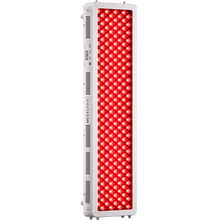Every day, your cells face tiny battles you can’t see—but they matter. Air pollution, poor sleep, processed food, and even stress can lead to oxidative stress, a kind of silent wear-and-tear that chips away at how well your body works. Scientists now know that giving cells a boost of energy can help them fight back. Red light therapy taps into that idea, delivering targeted light that recharges your cells and strengthens their natural defenses from the inside out.

What Is This Invisible Stress Inside Our Bodies?
Even when you're doing nothing, sitting around, your body's working overtime. Within each cell, miniature chemical reactions occur minute by minute to keep you alive, creating energy, digesting food, and fixing damage. But during this process, your body also makes something called free radicals. These are unstable molecules that can harm cells if they build up too much.
What Are Free Radicals?
Free radicals are unpaired-electron molecules, making them highly reactive. Your body generates them naturally through processes such as breathing, digestion, and exercise. They're not all bad—your immune system even utilizes them to battle infection. But when they're too abundant and there aren't sufficient antioxidants to manage them, they begin annihilating good cells.
What Causes Oxidative Stress to Get Worse?
While free radicals form naturally, some things increase how many your body makes. These include:
- Air pollution
- Smoking or secondhand smoke
- Processed foods high in sugar or unhealthy fats
- Alcohol
- UV exposure
- Long-term mental stress
Even poor sleep can make it harder for your body to recover, giving oxidative stress a chance to build up.
What Can Oxidative Stress Do to Your Body?
Over time, oxidative stress can damage proteins, DNA, and cell membranes. This has been linked to many health problems, such as:
- Faster aging of skin and organs
- Chronic inflammation
- Heart disease
- Diabetes
- Cognitive decline
Think of oxidative stress like slow rust on metal. You might not see it right away, but the damage adds up.
How Can the Body Defend Itself?
Your body naturally makes antioxidants to help neutralize free radicals. You also get antioxidants from healthy foods like berries, leafy greens, and nuts. But sometimes, especially with modern lifestyles, your system needs extra support.
That’s where scientific tools like red light therapy come in, aiming to give your cells more energy so they can do their job better, including fighting back against oxidative stress.
What Is Red Light Therapy and How Does It Work?
Red light therapy is a non-invasive and gentle treatment that utilizes certain wavelengths of light to improve your body at a cellular level. It's not dangerous and will not burn or hurt your skin. It provides low-level red and near-infrared light that your cells are able to absorb, more specifically, the energy-producing part of the cells.
What Kind of Light Does It Use?
Red light therapy uses two main types of light:
- Red light (around 620–750 nanometers): This light can be generated by a red light therapy device, which reaches both the surface and subcutaneous layers of the skin to help improve skin health, reduce inflammation, and stimulate collagen production.
- Near-infrared light (around 750–1100 nanometers): This light penetrates deeper into your body. It is utilized to assist muscles, joints, and even further internal organs by reaching more layers of tissue.
They are both in the natural light category, identical to sunlight, but without the dangerous UV rays.
How Is It Different from UV or Laser Treatments?
Red light therapy is sometimes confused with tanning beds or cosmetic lasers, but they are very different:
- No UV rays: Red light therapy won't tan or harm your skin since it doesn't have ultraviolet light.
- No heat or pain: The light is warm but not hot. It will not burn or irritate your skin.
- No downtime: You can treat red light therapy in your clinic or home and resume your day immediately—you don't have to recover.
It's widely applied in spas, dermatological clinics, or even via handheld devices at home.
What Does Red Light Do Inside Your Body?
When red or near-infrared light enters your skin, it reaches the mitochondria in your cells—the parts responsible for making energy. This gentle boost helps your cells work better, heal faster, and respond more strongly to stress or damage. It’s like giving your body’s repair system a little extra fuel to do its job.
Whether it’s used for skin repair, muscle recovery, or reducing inflammation, red light therapy works with your body, not against it. That’s why more people are turning to it as a safe, natural wellness tool.
What Is the Connection Between Cellular Energy and Fighting Stress?
When your cells have more energy, your whole body functions more efficiently. That means your very own resistance to oxidative stress—the internal damage brought about by having too many free radicals. Red light therapy makes your cells create more ATP, the energy they utilize to be healthy, repair themselves, and resist unfavorable processes. When you're more energized, your body not only functions more smoothly—it also resists everyday stress more intensely on the cellular level.
Here’s how increased cellular energy directly helps protect your health:
More Energy Means More Antioxidants
Antioxidants are your first defense against free radicals in your body. You get some from your diet, but your body also makes its own. ATP is necessary to fuel the process. When your cells have the energy they require, they can make more natural antioxidants such as glutathione, which works to disarm free radicals before they can cause any harm.
Cells Repair Themselves Faster
Free radicals target the cell's vital components, such as proteins and DNA. Your body's repair crews are powered by ATP. The more energy you have, the faster your cells can repair the damage, rebuild the structure, and keep tissues in good working condition. It retards the signs of aging and promotes long-term health.
Stronger Defense Against Inflammation
Oxidative stress and chronic inflammation typically come together. When your cells are more energized, they are more capable of modulating the immune system and minimizing excessive inflammation. This translates into less pain, healthier healing, and a more even-keeled body response.
Less Cellular Waste Build-Up
Cellular waste—such as proteins that are damaged or molecules that are oxidized—can accumulate when cells are fatigued and lack energy. ATP fuels cleanup efforts such as autophagy, in which old, damaged cellular components are eliminated and recycled. Red light therapy enhances this process, which keeps your cells clean and efficient.
Better Long-Term Resilience
Your body is constantly striving to remain in balance. With more ATP, cells can get ahead of stress rather than simply responding to it. Over time, that translates to improved energy levels, enhanced immunity, and healthier aging.
When your cells are well-powered, they don't just survive—they actively fight back. Red light therapy gives your body the energy it needs to stay strong from the inside out.

What Are the Key Cellular Benefits of Red Light Therapy?
Red light therapy does more than just help your body fight oxidative stress. When your cells have more energy, they perform better across many areas—repairing tissue, sending clearer signals, and building important structural proteins. These changes may start small, but they add up to big improvements in how your body feels, heals, and stays strong over time.
Here are some of the most important benefits happening inside your cells:
Inflammation Goes Down
Chronic inflammation is usually associated with pain, fatigue, and long-term illness. With more ATP available, your cells react to damage or irritation more proportionally. Red light therapy has been demonstrated to reduce inflammation markers by soothing overactive immune responses, which can lead to joint comfort, muscle recovery, and even skin health.
Cell Signaling Gets Better
Your body operates through communication—cells continuously send and receive messages to remain in harmony. When energy levels are high, those messages are more precise and timely. That accelerates healing, coordinates immune response, and maximizes how effectively tissues work with one another. It's as if you're giving your body's internal communication system a signal boost.
Elastin and Collagen Production Increases
Collagen and elastin are proteins that make your skin smooth, tight, and elastic. As we get older, our production decreases. Red light therapy activates the fibroblasts, the cells that make those proteins, and leaves your skin with improved texture, fewer fine lines, and a quicker recovery from wounds. That's partly why it's used for beauty treatments.
Muscle and Joint Tissues Recover Faster
When energy levels are low, repair of muscle and joints can grind to a halt. Red light therapy increases energy precisely where it's needed so that cells in muscles, tendons, and ligaments heal more quickly. Athletes and individuals with arthritis frequently use this therapy to alleviate soreness and improve range of motion.
Cells Remain Healthier, Longer
Additional ATP provides cells with the energy to clear out trash, fight off damage, and get in top shape. This overall energy boost can fuel improved brain function, better sleep, and overall resilience. It's not so much a quick fix—it's about getting your body to work better from the inside out.
Is Red Light Therapy a Natural Wellness Tool?
Yes—it’s a natural way to support your body’s health.
Red light therapy doesn’t use drugs or chemicals. Instead, it uses red and near-infrared light to help your cells do what they already do—like make energy, repair damage, and reduce inflammation. It gently supports healing without forcing any changes. The portable red light therapy device is also easy to use.
That’s why many people use it to manage stress, ease joint pain, improve skin, or recover faster. It fits well with natural wellness habits focused on long-term health, not just quick fixes.
What Does a Typical Red Light Therapy Session Feel Like?
Red light therapy is one of the easiest treatments to try—no pain, no prep, no downtime. Whether you’re at a clinic or using a device at home, the experience is simple and usually quite relaxing.
- It Doesn’t Hurt: The light doesn’t burn, sting, or irritate. Most people just feel a gentle warmth on the skin. No needles, no gels, and nothing invasive. It’s safe for all skin types when used properly.
- Sessions Are Short: Most last 10 to 20 minutes, depending on the area you’re treating and the strength of the device. Full-body treatments or deep-tissue sessions may take a bit longer, but skincare or spot treatments are usually quicker.
- You Just Sit or Lie Down: There’s nothing you need to do during a session. The device is placed 6 inches from your skin, and some setups include goggles if you're treating areas near the eyes. Then you just relax and let the light do its work. If you don’t want to be affected by your walking during treatment, you can also choose a red light therapy belt.
- How Often You Use It: For general wellness or skin support, people often start with 3–5 sessions per week. Athletes or people recovering from injury might use it more often based on their recovery plan. Results build gradually with consistent use.
- No Downtime After: You can go back to your day right away. Some users feel calm or refreshed afterward, while others start noticing benefits like clearer skin or less muscle soreness over a few weeks.
In short, red light therapy feels like a warm, quiet break—and it fits easily into most routines.
Feel Better from the Inside with Red Light Therapy for Oxidative Stress
Your body works hard every day, and oxidative stress can slowly wear it down. Red light therapy gives your cells the extra energy they need to stay strong, repair damage, and protect against free radicals. It’s a simple, natural way to support your health without pills or harsh treatments. If you want to take better care of your body over time, adding red light therapy to your routine could be a smart step forward.














 Small
Small

 Moderate
Moderate

 Moderate
Moderate

 Moderate
Moderate

 Full
Full



